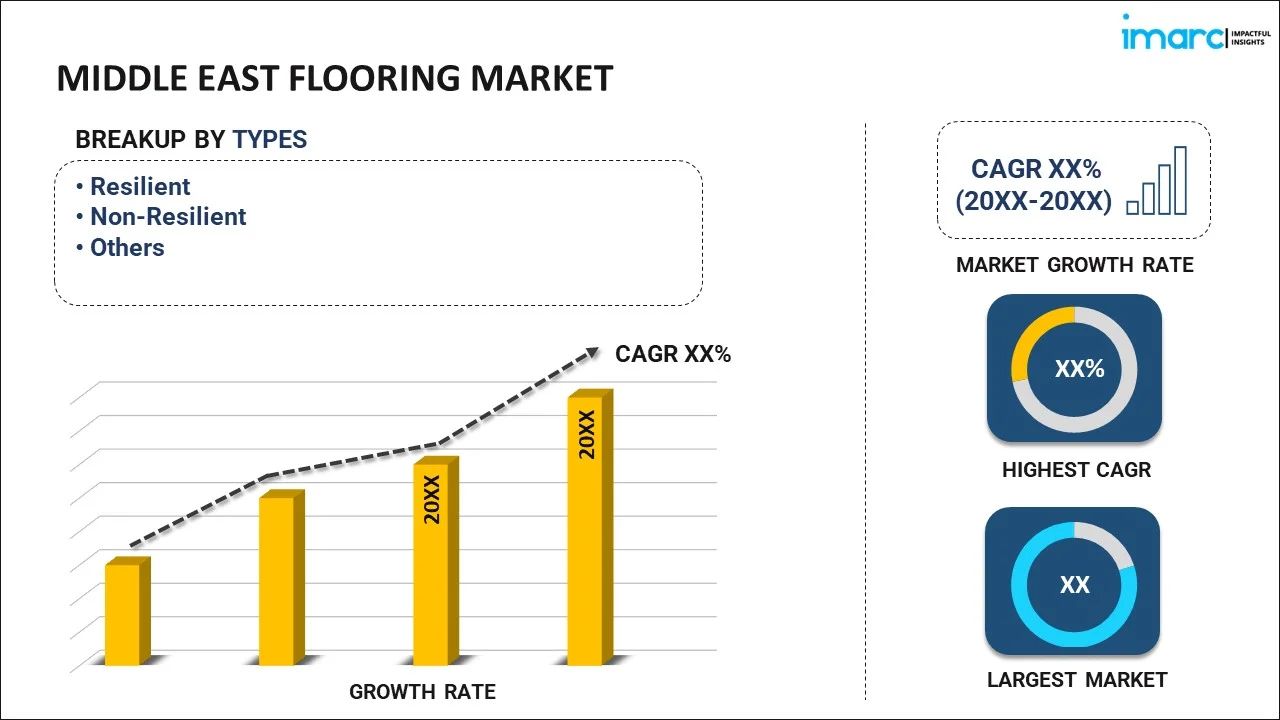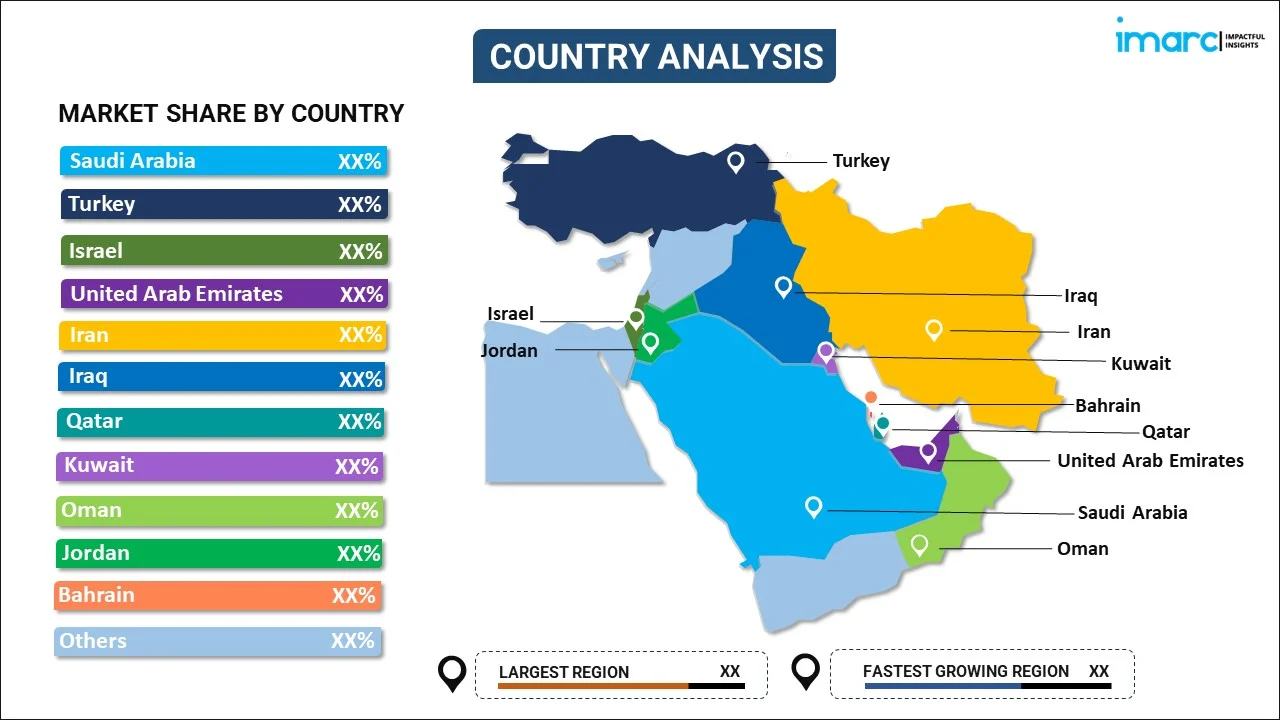
Middle East Flooring Market Report by Type (Resilient, Non-Resilient, and Others), End User (Residential, Non-Residential), and Country 2025-2033
Market Overview:
Middle East flooring market size reached USD 17.9 Billion in 2024. Looking forward, IMARC Group expects the market to reach USD 38.0 Billion by 2033, exhibiting a growth rate (CAGR) of 8.08% during 2025-2033. The rising infrastructural development activities and the widespread adoption of eco-friendly flooring products represent some of the key factors driving the market.
|
Report Attribute
|
Key Statistics
|
|---|---|
|
Base Year
|
2024
|
|
Forecast Years
|
2025-2033
|
|
Historical Years
|
2019-2024
|
|
Market Size in 2024
|
USD 17.9 Billion |
|
Market Forecast in 2033
|
USD 38.0 Billion |
| Market Growth Rate 2025-2033 | 8.08% |
Flooring pertains to the materials utilized for covering the floor surface in residential, commercial, and industrial settings. Its purpose is twofold, serving functional and aesthetic roles by providing a stable and long-lasting foundation while enhancing the visual appeal of the area. The available options are diverse, encompassing hardwood, laminate, vinyl, tile, carpet, and more, each possessing distinctive characteristics and advantages. The selection process relies on factors such as the intended usage of the space, design preferences, durability requirements, and maintenance considerations. Flooring plays a pivotal role in establishing the ambiance and style of a room, thereby influencing the overall aesthetic of the environment. Additionally, it contributes to comfort, noise reduction, and insulation. With ongoing advancements in technology and design, the industry is evolving to present innovative and sustainable solutions that cater to the needs of contemporary spaces, ensuring durability, versatility, and ease of installation and maintenance.
Middle East Flooring Market Trends:
The Middle East flooring market is undergoing a notable transformation, reflecting a dynamic intersection of functionality, aesthetics, and technological advancements. As residential, commercial, and industrial spaces evolve in the region, the demand for diverse and innovative flooring solutions has surged. Moreover, the market offers a wide array of options, including hardwood, ceramic tiles, vinyl, carpet, and laminate, each catering to distinct preferences and requirements. Besides this, factors such as climate, cultural influences, and sustainability considerations play pivotal roles in shaping the choices of flooring materials. In response to the growing emphasis on environmentally conscious practices, sustainable flooring solutions have gained momentum. Additionally, technological advancements have introduced new materials and installation techniques, further diversifying the market landscape. Governments and businesses in the Middle East are increasingly investing in urban development projects, contributing to the flourishing construction industry and, consequently, the demand for high-quality flooring materials. The market's growth is also fueled by a rising awareness of the impact of flooring choices on indoor air quality, health, and overall well-being. As the region embraces modernization, the Middle East flooring market will stand as a key player, offering a blend of tradition and innovation to meet the evolving needs of diverse and dynamic spaces, over the forecasted period.
Middle East Flooring Market Segmentation:
IMARC Group provides an analysis of the key trends in each segment of the market, along with forecasts at the regional and country levels for 2025-2033. Our report has categorized the market based on type and end user.
Type Insights:

- Resilient
- Non-Resilient
- Others
The report has provided a detailed breakup and analysis of the market based on the type. This includes resilient, non-resilient, and others.
End User Insights:
- Residential
- Non-Residential
A detailed breakup and analysis of the market based on the end user have also been provided in the report. This includes residential and non-residential.
Country Insights:

- Saudi Arabia
- Turkey
- Israel
- United Arab Emirates
- Iran
- Iraq
- Qatar
- Kuwait
- Oman
- Jordan
- Bahrain
- Others
The report has also provided a comprehensive analysis of all the major regional markets, which include Saudi Arabia, Turkey, Israel, United Arab Emirates, Iran, Iraq, Qatar, Kuwait, Oman, Jordan, Bahrain, and Others.
Competitive Landscape:
The market research report has also provided a comprehensive analysis of the competitive landscape in the market. Competitive analysis such as market structure, key player positioning, top winning strategies, competitive dashboard, and company evaluation quadrant has been covered in the report. Also, detailed profiles of all major companies have been provided.
Middle East Flooring Market Report Coverage:
| Report Features | Details |
|---|---|
| Base Year of the Analysis | 2024 |
| Historical Period | 2019-2024 |
| Forecast Period | 2025-2033 |
| Units | Billion USD |
| Scope of the Report | Exploration of Historical Trends and Market Outlook, Industry Catalysts and Challenges, Segment-Wise Historical and Future Market Assessment:
|
| Types Covered | Resilient, Non-Resilient, Others |
| End Users Covered | Residential, Non-Residential |
| Countries Covered | Saudi Arabia, Turkey, Israel, United Arab Emirates, Iran, Iraq, Qatar, Kuwait, Oman, Jordan, Bahrain, Others |
| Customization Scope | 10% Free Customization |
| Post-Sale Analyst Support | 10-12 Weeks |
| Delivery Format | PDF and Excel through Email (We can also provide the editable version of the report in PPT/Word format on special request) |
Key Questions Answered in This Report:
- How has the Middle East flooring market performed so far and how will it perform in the coming years?
- What has been the impact of COVID-19 on the Middle East flooring market?
- What is the breakup of the Middle East flooring market on the basis of type?
- What is the breakup of the Middle East flooring market on the basis of end user?
- What are the various stages in the value chain of the Middle East flooring market?
- What are the key driving factors and challenges in the Middle East flooring?
- What is the structure of the Middle East flooring market and who are the key players?
- What is the degree of competition in the Middle East flooring market?
Key Benefits for Stakeholders:
- IMARC’s industry report offers a comprehensive quantitative analysis of various market segments, historical and current market trends, market forecasts, and dynamics of the Middle East flooring market from 2019-2033.
- The research report provides the latest information on the market drivers, challenges, and opportunities in the Middle East flooring market.
- Porter's five forces analysis assist stakeholders in assessing the impact of new entrants, competitive rivalry, supplier power, buyer power, and the threat of substitution. It helps stakeholders to analyze the level of competition within the Middle East flooring industry and its attractiveness.
- Competitive landscape allows stakeholders to understand their competitive environment and provides an insight into the current positions of key players in the market.
Need more help?
- Speak to our experienced analysts for insights on the current market scenarios.
- Include additional segments and countries to customize the report as per your requirement.
- Gain an unparalleled competitive advantage in your domain by understanding how to utilize the report and positively impacting your operations and revenue.
- For further assistance, please connect with our analysts.

 Inquire Before Buying
Inquire Before Buying
 Speak to an Analyst
Speak to an Analyst
 Request Brochure
Request Brochure
 Request Customization
Request Customization



.webp)




.webp)












